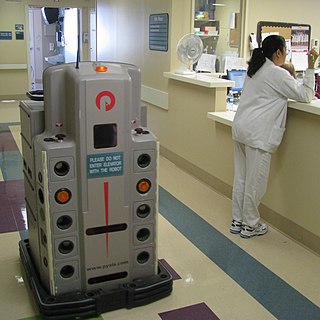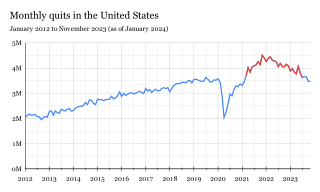Related Research Articles

Labour economics, or labor economics, seeks to understand the functioning and dynamics of the markets for wage labour. Labour is a commodity that is supplied by labourers, usually in exchange for a wage paid by demanding firms. Because these labourers exist as parts of a social, institutional, or political system, labour economics must also account for social, cultural and political variables.
A minimum wage is the lowest remuneration that employers can legally pay their employees—the price floor below which employees may not sell their labor. Most countries had introduced minimum wage legislation by the end of the 20th century. Because minimum wages increase the cost of labor, companies often try to avoid minimum wage laws by using gig workers, by moving labor to locations with lower or nonexistent minimum wages, or by automating job functions. Minimum wage policies can vary significantly between countries or even within a country, with different regions, sectors, or age groups having their own minimum wage rates. These variations are often influenced by factors such as the cost of living, regional economic conditions, and industry-specific factors.

An informal economy is the part of any economy that is neither taxed nor monitored by any form of government. Although the informal sector makes up a significant portion of the economies in developing countries, it is sometimes stigmatized as troublesome and unmanageable. However, the informal sector provides critical economic opportunities for the poor and has been expanding rapidly since the 1960s. Integrating the informal economy into the formal sector is an important policy challenge.

A blue-collar worker is a person who performs manual labor or skilled trades. Blue-collar work may involve skilled or unskilled labor. The type of work may involve manufacturing, retail, warehousing, mining, excavation, carpentry, electricity generation and power plant operations, electrical construction and maintenance, custodial work, farming, commercial fishing, logging, landscaping, pest control, food processing, oil field work, waste collection and disposal, recycling, construction, maintenance, shipping, driving, trucking, and many other types of physical work. Blue-collar work often involves something being physically built or maintained. In social status, blue-collar workers generally belong to the working class.

Employment is a relationship between two parties regulating the provision of paid labour services. Usually based on a contract, one party, the employer, which might be a corporation, a not-for-profit organization, a co-operative, or any other entity, pays the other, the employee, in return for carrying out assigned work. Employees work in return for wages, which can be paid on the basis of an hourly rate, by piecework or an annual salary, depending on the type of work an employee does, the prevailing conditions of the sector and the bargaining power between the parties. Employees in some sectors may receive gratuities, bonus payments or stock options. In some types of employment, employees may receive benefits in addition to payment. Benefits may include health insurance, housing, and disability insurance. Employment is typically governed by employment laws, organisation or legal contracts.

Underemployment is the underuse of a worker because their job does not use their skills, offers them too few hours, or leaves the worker idle. It is contrasted with unemployment, where a person lacks a job at all despite wanting one.

A migrant worker is a person who migrates within a home country or outside it to pursue work. Migrant workers usually do not have an intention to stay permanently in the country or region in which they work.
The weekdays and weekend are the complementary parts of the week devoted to labour and rest, respectively. The legal weekdays, or workweek, is the part of the seven-day week devoted to working. In most of the world, the workweek is from Monday to Friday and the weekend is Saturday and Sunday. A weekday or workday is any day of the working week. Other institutions often follow this pattern, such as places of education. The constituted weekend has varying definitions, based on determined calendar days, designated period of time, and/or regional definition of the working week. Sometimes the term "weekend" is expanded to include the time after work hours on the last workday of the week. Weekdays and workdays can be further detailed in terms of working time, the period of time that an individual spends at paid occupational labor.

Abstract labour and concrete labour refer to a distinction made by Karl Marx in his critique of political economy. It refers to the difference between human labour in general as economically valuable worktime versus human labour as a particular activity that has a specific useful effect within the (capitalist) mode of production.

The labor force in Japan numbered 65.9 million people in 2010, which was 59.6% of the population of 15 years old and older, and amongst them, 62.57 million people were employed, whereas 3.34 million people were unemployed which made the unemployment rate 5.1%. The structure of Japan's labor market experienced gradual change in the late 1980s and continued this trend throughout the 1990s. The structure of the labor market is affected by: 1) shrinking population, 2) replacement of postwar baby boom generation, 3) increasing numbers of women in the labor force, and 4) workers' rising education level. Also, an increase in the number of foreign nationals in the labor force is foreseen.

In economics, the Baumol effect, also known as Baumol's cost disease, first described by William J. Baumol and William G. Bowen in the 1960s, is the tendency for wages in jobs that have experienced little or no increase in labor productivity to rise in response to rising wages in other jobs that did experience high productivity growth. In turn, these sectors of the economy become more expensive over time, because their input costs increase while productivity does not. Typically, this affects services more than manufactured goods, and in particular health, education, arts and culture.
Low-cost country sourcing (LCCS) is procurement strategy in which a company sources materials from countries with lower labour and production costs in order to cut operating expenses. LCCS falls under a broad category of procurement efforts called global sourcing.

In the United States, the minimum wage is set by U.S. labor law and a range of state and local laws. The first federal minimum wage was instituted in the National Industrial Recovery Act of 1933, signed into law by President Franklin D. Roosevelt, but later found to be unconstitutional. In 1938, the Fair Labor Standards Act established it at 25¢ an hour. Its purchasing power peaked in 1968, at $1.60. In 2009, Congress increased it to $7.25 per hour with the Fair Minimum Wage Act of 2007, and has not increased it since.
A dead-end job is a job where there is little or no chance of career development and advancement into a better position. If an individual requires further education to progress within their firm that is difficult to obtain for any reason, this can result in the occupation being classified as a dead-end position. Based on human resources and career strategist Toni Howard Lowe, some individuals who have worked for the same company for several years may not be privy to the signs that they are currently employed in a dead-end job.

Technological unemployment is the loss of jobs caused by technological change. It is a key type of structural unemployment. Technological change typically includes the introduction of labour-saving "mechanical-muscle" machines or more efficient "mechanical-mind" processes (automation), and humans' role in these processes are minimized. Just as horses were gradually made obsolete as transport by the automobile and as labourer by the tractor, humans' jobs have also been affected throughout modern history. Historical examples include artisan weavers reduced to poverty after the introduction of mechanized looms. Thousands of man-years of work was performed in a matter of hours by the bombe codebreaking machine during World War II. A contemporary example of technological unemployment is the displacement of retail cashiers by self-service tills and cashierless stores.
Women's education in Pakistan is a fundamental right of every female citizen, according to article thirty-seven of the Constitution of Pakistan, but gender discrepancies still exist in the educational sector. According to the 2011 Human Development Report of the United Nations Development Program, approximately twice as many males as females receive a secondary education in Pakistan, and public expenditures on education amount to only 2.7% of the GDP of the country. The unemployment rate of female graduates in Pakistan is approximately 3.8 times higher than that of their male counterparts.
The social and economic changes in Thailand in the past decades have important implications for the quality and quantity of labor. The economic and non-economic roles of women in Thailand can be traced back several hundred years in Thai history, when there were traditional discriminatory attitudes towards women in the culture of Thailand. The transformation of Thailand's social and economic structure since the 1960s led to the gender disparities in Thai society. Recently, the position of Thai women in the labor market has improved a lot in comparison to the past as a result of modernization. In 2011, Thailand ranked 69th out of 143 countries in the Gender Inequality Index. In labor economics, gender inequality is widely discussed in terms of concepts of sex segregation and employment discrimination. Thai government and non-governmental organizations have put forth many policies and programs to address gender inequalities in the last few decades.

Clothing industry or garment industry summarizes the types of trade and industry along the production and value chain of clothing and garments, starting with the textile industry, embellishment using embroidery, via the fashion industry to apparel retailers up to trade with second-hand clothes and textile recycling. The producing sectors build upon a wealth of clothing technology some of which, like the loom, the cotton gin, and the sewing machine heralded industrialization not only of the previous textile manufacturing practices. Clothing industries are also known as allied industries, fashion industries, garment industries, or soft goods industries.
Palestinian workers in Israel are Palestinian citizens of the Palestinian Authority who are employed by Israeli citizens in the State of Israel and Israeli settlements in the West Bank. Most of them work as unskilled laborers in sectors such as agriculture and construction.

The Great Resignation, also known as the Big Quit and the Great Reshuffle, was a mainly American economic trend in which employees voluntarily resigned from their jobs en masse, beginning in early 2021 during the COVID-19 pandemic. Among the most cited reasons for resigning included wage stagnation amid rising cost of living, limited opportunities for career advancement, hostile work environments, lack of benefits, inflexible remote-work policies, and long-lasting job dissatisfaction. Most likely to quit were workers in hospitality, healthcare, and education. In addition, many of the resigning workers were retiring Baby Boomers, who are one of the largest demographic cohorts in the United States.
References
- 1 2 https://www.cbc.ca/radio/sunday/the-sunday-edition-february-11-2018-1.4528197/michael-s-essay-we-don-t-value-menial-work-and-we-should-1.4528219
- ↑ Santry, Charlotte (October 26, 2010). "Nursing seen as hard, nasty and menial".
- ↑ "Pakistan: Government puts end to menial job ads targeting religious minorities - Vatican News". www.vaticannews.va. June 1, 2022.
- ↑ "Human rights violations against Dalits in the form of menial jobs". evidence.org.in.
- ↑ "Pakistan job quotas for Non-Muslim qualifies for sanitation work only". www.pakistanchristianpost.com.
- ↑ "Swapping the stage for a deli: To pay bills, Israelis compete for menial jobs | The Times of Israel".
- ↑ "Over 250,000 college graduates work at menial labor". koreatimes. July 23, 2018.
- ↑ "Special report: A degree in architecture … but all I can get are". The Standard. September 21, 2012.
- ↑ "Out of jobs, graduates, MBAs turn to unskilled labour under MGNREGA for survival". India Today. September 25, 2020.
- ↑ "Women take on menial jobs | D+C - Development + Cooperation". www.dandc.eu. December 16, 2019.
- ↑ Singh, Rajvinder. "67% of vacancies are for menial jobs". thesun.my.
- ↑ Kasperkevic, Jana (March 30, 2014). "Retail, service and hospitality jobs: hard work but 'no shame'" – via The Guardian.